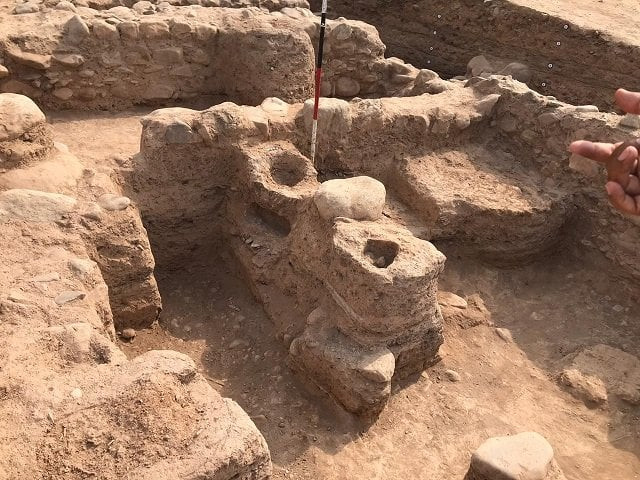Shrouds of history: A Greek fire once burned in Peshawar
Remains of Greek forge have been discovered, the latest in findings highlighting K-P’s Indo-Greek history

Remains of a Greek forge have been discovered in the city, the latest in a long line findings highlighting K-P’s Indo-Greek history. PHOTO: EXPRESS
It seems that fire and knowledge of how to use it, at least in the Greek way, found itself thousands of miles from the shores of the Aegean all the way to the valley of Peshawar – or so reveals a recent archaeological discovery.
 PHOTO: EXPRESS
PHOTO: EXPRESS“We found the remains of an Indo-Greek forge believed to be 2,200 years old in Hayatabad Town Phase V,” said archaeologist Professor Gul Rahim, who led the University of Peshawar team involved in the discovery. “We have completed all studies at the site we began excavating in 2017 and have now started to fill it back up,” he told The Express Tribune.
Mughal-era Royal Bath unearthed in Lahore's Shahi Qila
“This is a major archaeological discovery pertaining to the Indo-Greek period,” insisted Prof Rahim. “It indicates that the area that is now Peshawar was a crucial node in the trade of arms, armour and other metal goods along the ancient Khyber Pass.”
“The remains of the forge show signs of north-south construction typical of Greek architecture,” Prof Rahim said while explaining how archaeologists concluded that the Hayatabad site belonged to the Indo-Greek period. “We believe the ore used in forge was obtained locally,” he added, providing other details his team gleaned from the site.

“We are currently in the process of drafting a number of research papers based on our findings to keep the archaeological community abreast of this site,” Prof Rahim said. “It is a shame we were not able to extend the dig to Jamrud Road due to some work to facilitate dumping of industrial waste. It could have revealed so much more.”
Still, he thanked the University of Peshawar for providing Rs1 million for the dig and associated research. He also appreciated the Edwards School and College administration for allowing permission to carry out excavation on land allotted to the institute. Prof Rahim urged the government and the United Nations Educational, Scientific and Cultural Organisation (Unesco) to declare the location a heritage site and develop it into a tourist attraction.
Who were the Indo-Greeks?
The Indo-Greek or Graeco-Indian Kingdom refers to a series of Hellenistic dynastic polities that ruled over an area spanning parts of modern-day Afghanistan, Khyber-Pakhtunkhwa and Punjab from 180 BC to 10 AD. The polities are traditionally associated with several regional capitals like Taxila, Sagala (Sialkot) and Pushkalavati, the capital of the Gandhara kingdom the ruins of which lie on the outskirts of Charsadda.
The kingdom was founded when Graeco-Bactrian king Demetrius invaded the subcontinent early in the 2nd century BC. The Greeks in the subcontinent eventually split from the Graeco-Bactrians in Bactria, the Greek name for the region encompassing the border between Afghanistan and Uzbekistan. Over the course of nearly two centuries, the Indo-Greek Kingdom was ruled by more than 30 kings who were often involved in conflict with one another.
“Ethnically, the Indo-Greeks and the Graeco-Bactrians must predominantly have been people who lived in these lands before Alexander and his armies came to Bactria and the subcontinent,” said Nawazuddin Khan, a research officer at the K-P Directorate of Archaeology. “Other Indo-Greeks would have been descendants of intermixing between Greeks and the locals,” he told The Express Tribune.
Bringing back Lahore's diverse magnificence
According to Nawaz, when historians and archaelogists use the term Indo-Greek or Graeco-Bactrian, they mainly refer to a hybrid culture that arose from the diffusion of Greek culture in the subcontinent and Bactria. “This diffusion had a much wider influence on the region which lasted long after the kingdom ceased to exist,” he said.

“For instance, take Graeco-Buddhist art. The first ever statue of Buddha is actually a sort of replica of statues of Apollo, the Greek god of the sun,” Nawaz added. “The fact that we have Buddhist sculptures at all is also in itself a remnant of Greek influence. Most Buddhist schools of thought were against depicting Buddha in sculpture.”
A cradle for Indo-Greek research
According to Nawaz, K-P, being the heart of the Indo-Greek Kingdom, is filled to the brim with Indo-Greek sites. “Both Peshawar and Charsadda either were or lie very close to Indo-Greek capitals. The province is so rich in ancient history that often times, when a patch of land is dug up to lay the foundations of a house, we find traces of ancient settlements,” he said.
“There are more than 3,000 sites of historical importance all over K-P according to surveys conducted many years ago. In Peshawar alone, we have found more than 1,800 sites,” Nawaz pointed out. “This means there must be many more that we are as yet unaware of.”
Regarding the discovery of the Hayatabad site, the research officer said it resembles another site discovered at a depth of 50 feet in Gorkhathri. “Indo-Greek symbols as well as remains of factories were found at both sites,” he said. “This suggests the presence of a major Indo-Greek settlement here.”













COMMENTS
Comments are moderated and generally will be posted if they are on-topic and not abusive.
For more information, please see our Comments FAQ